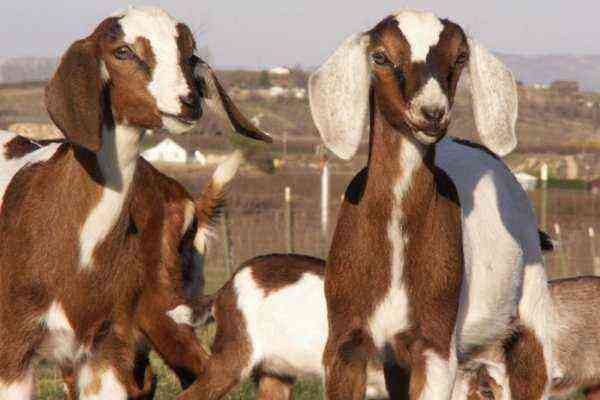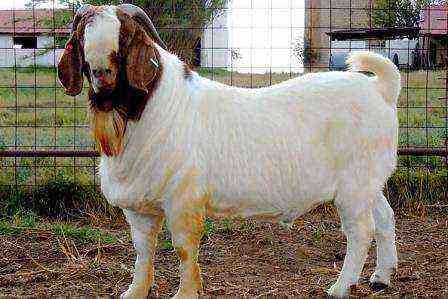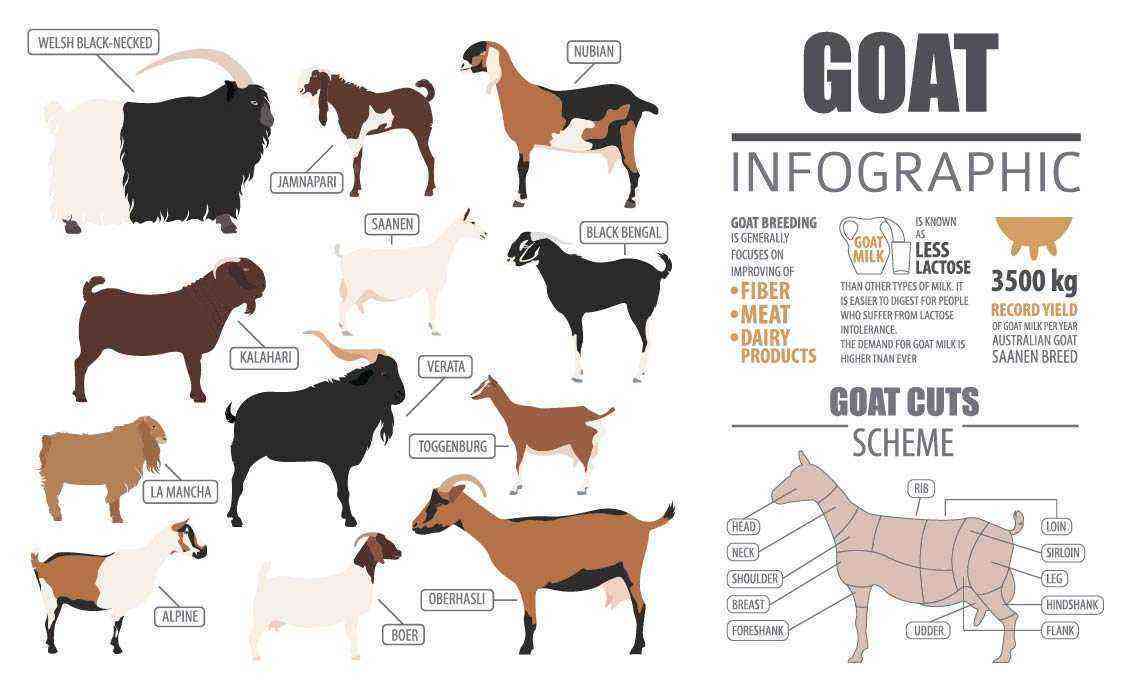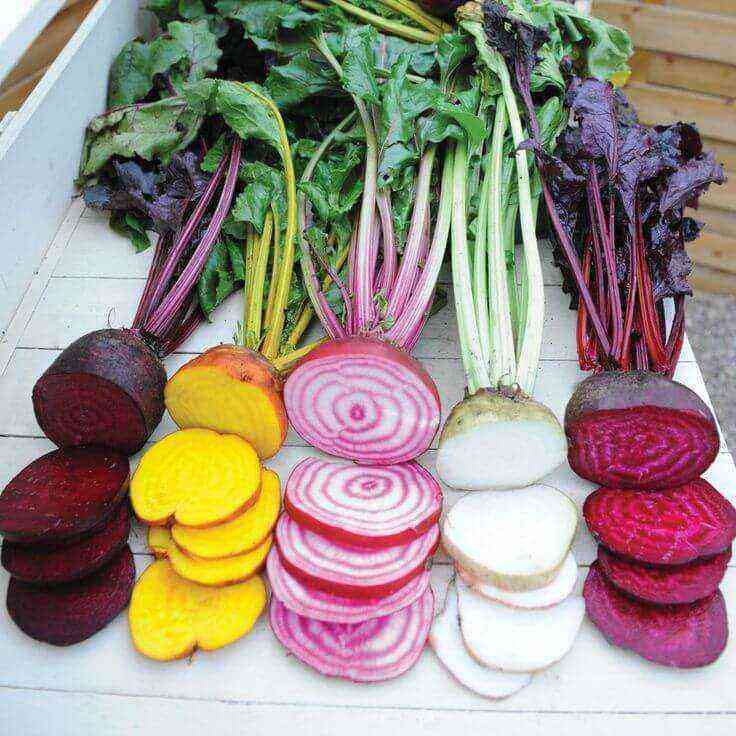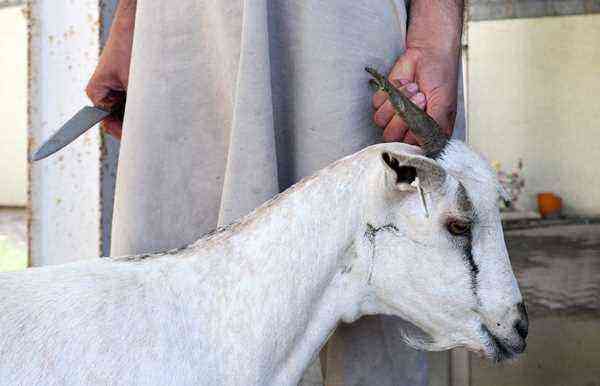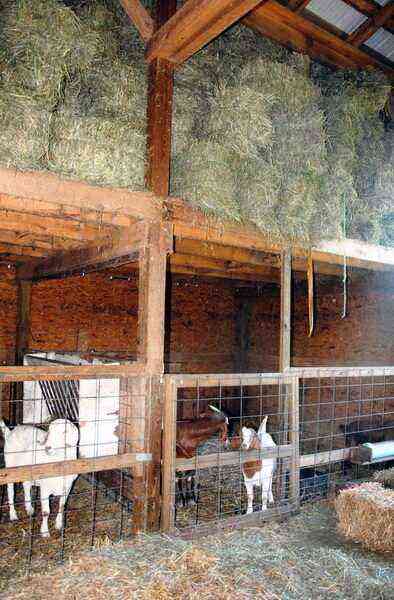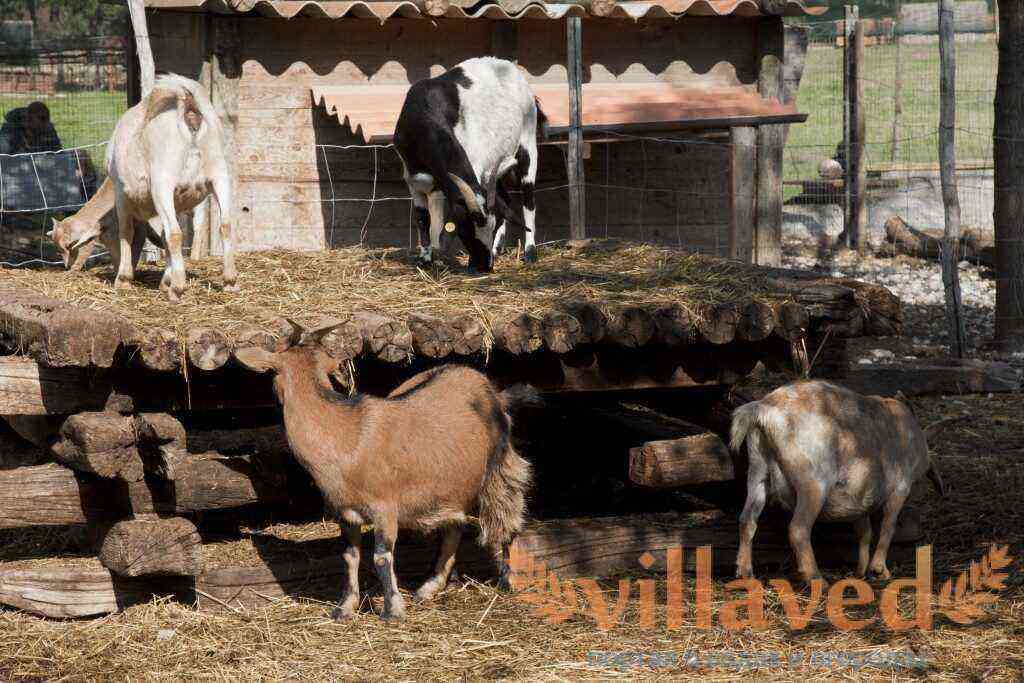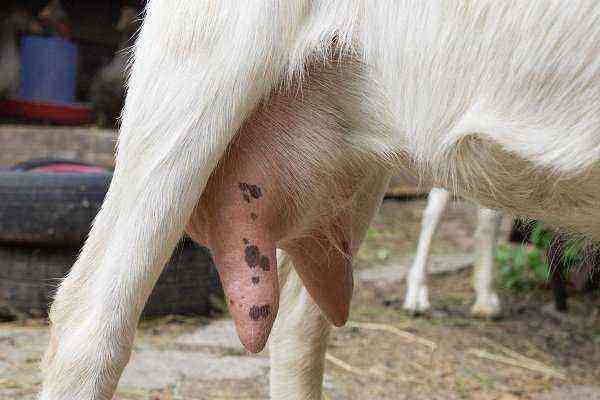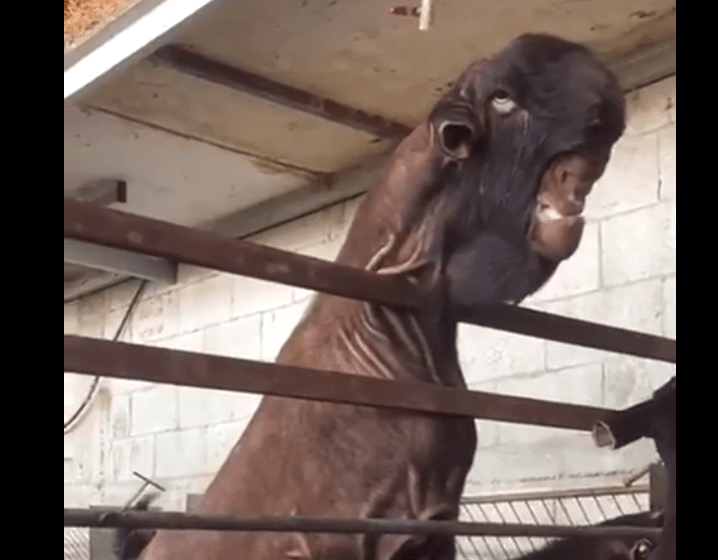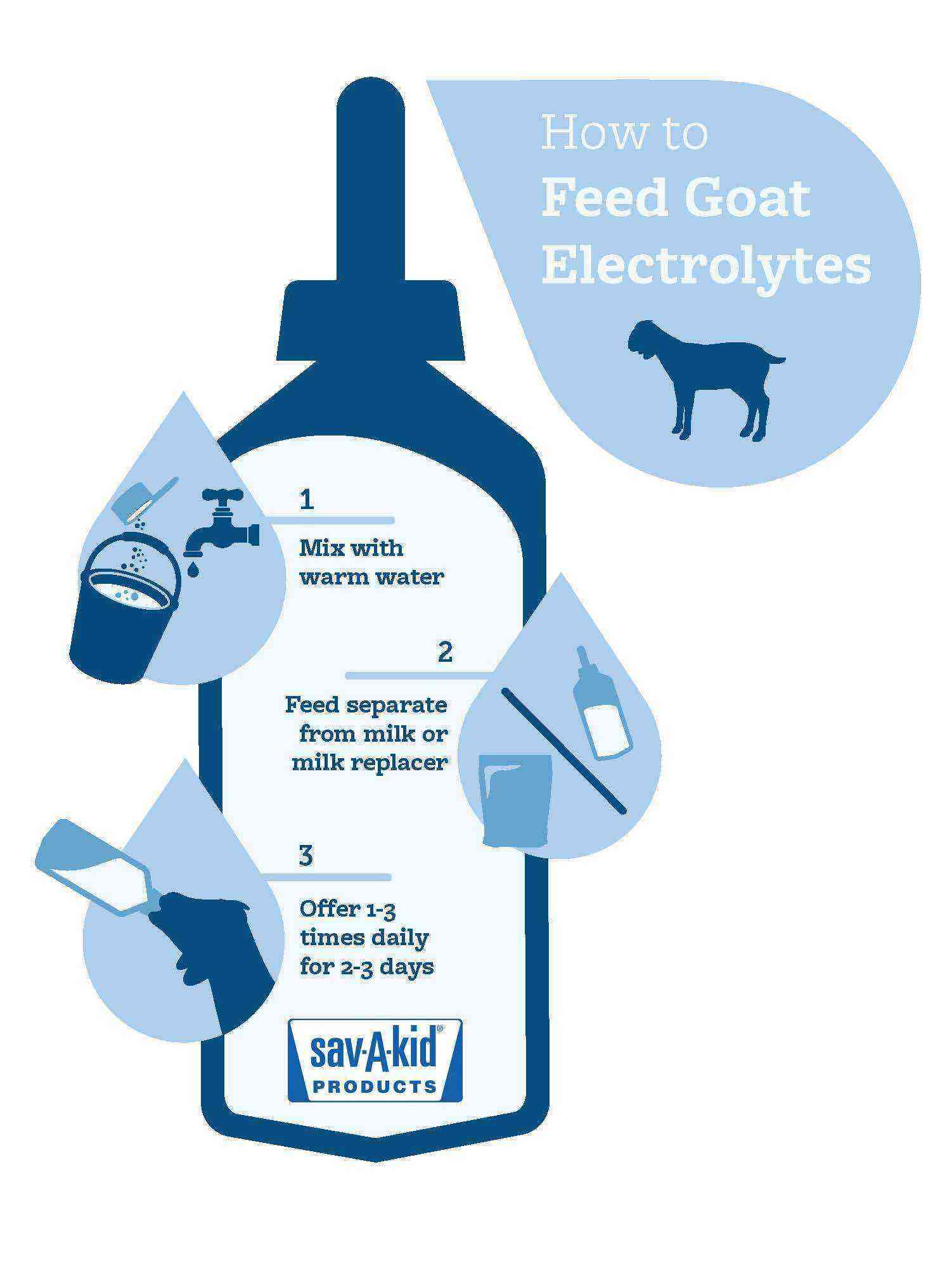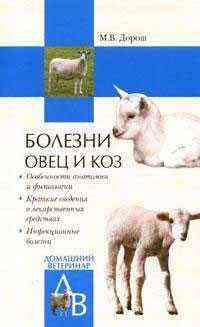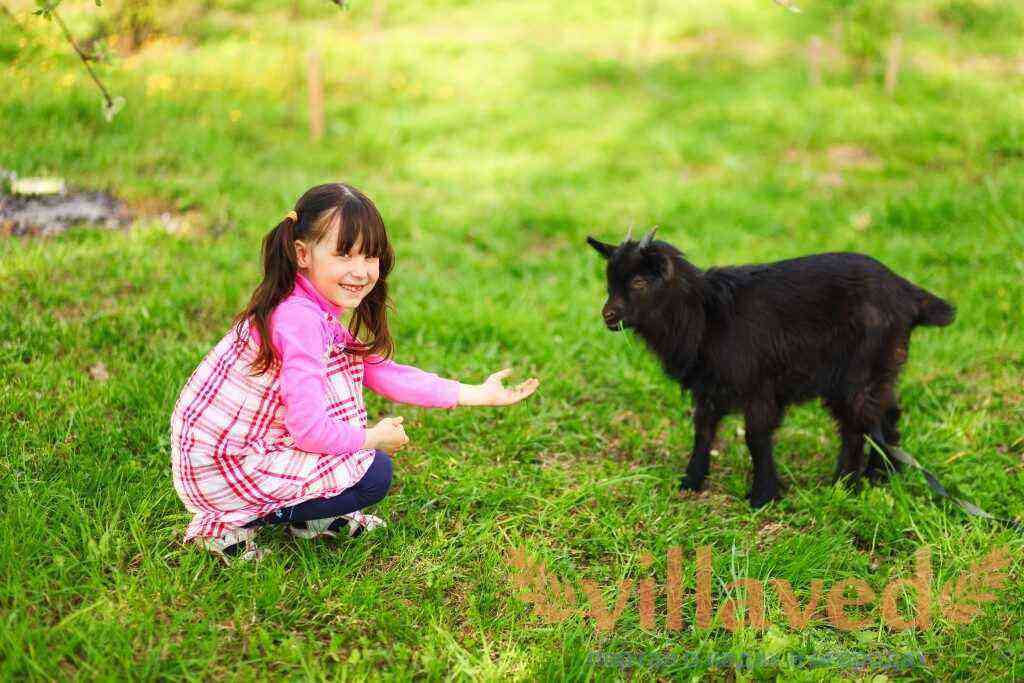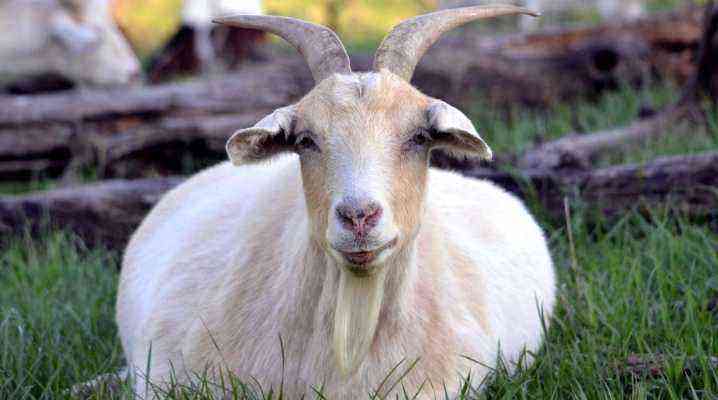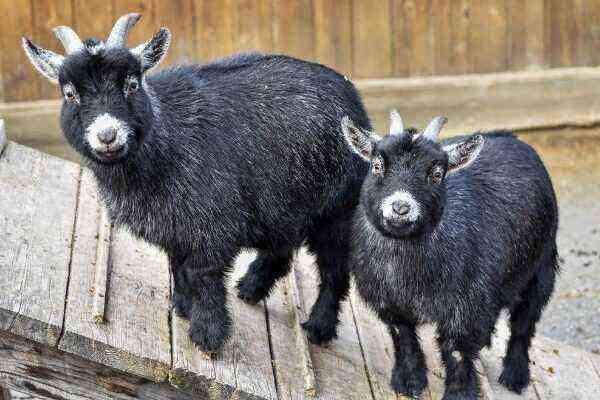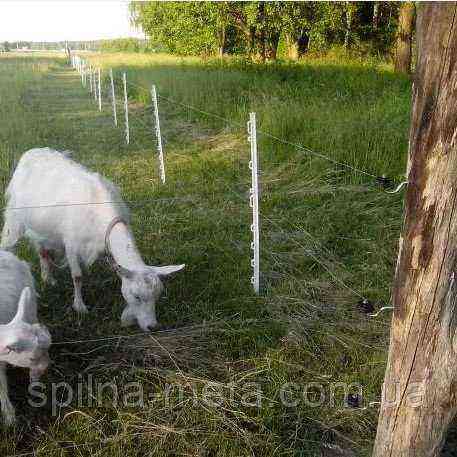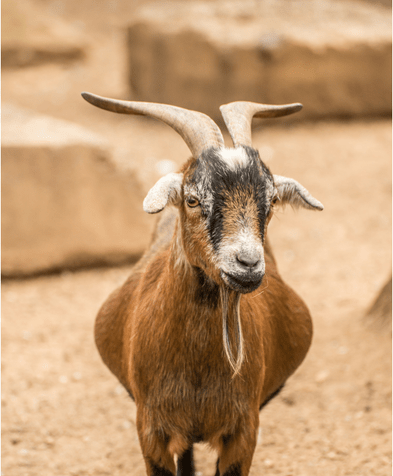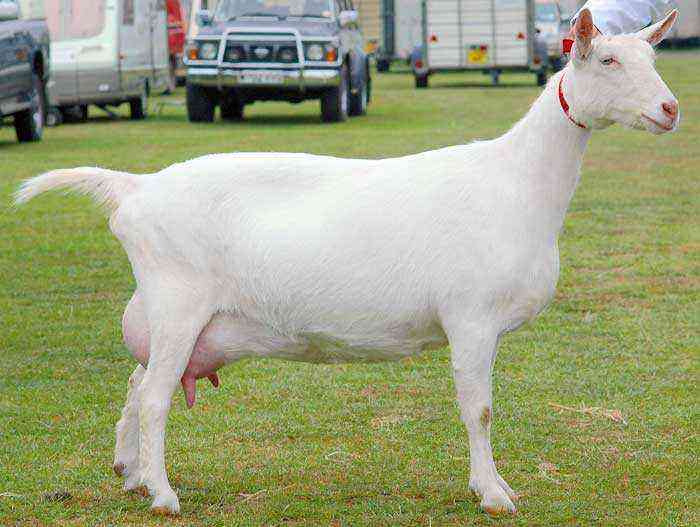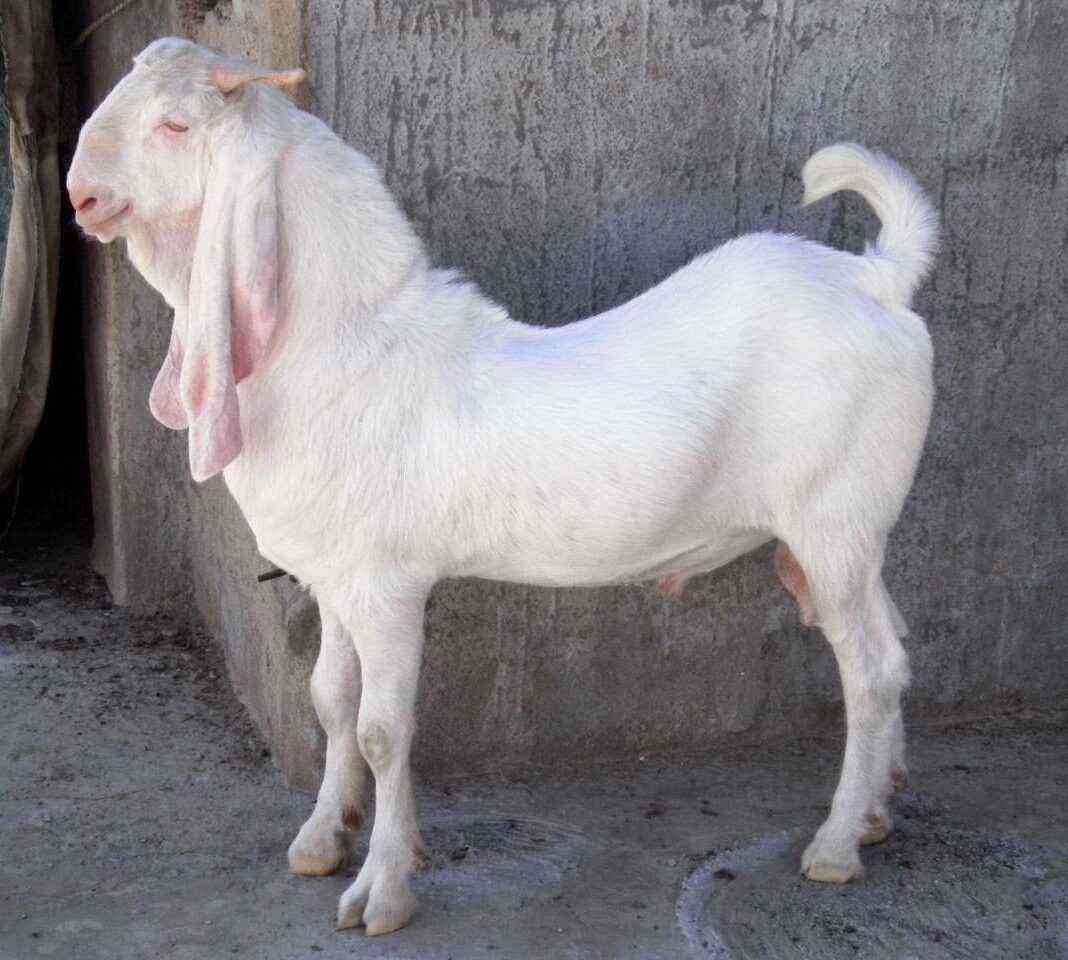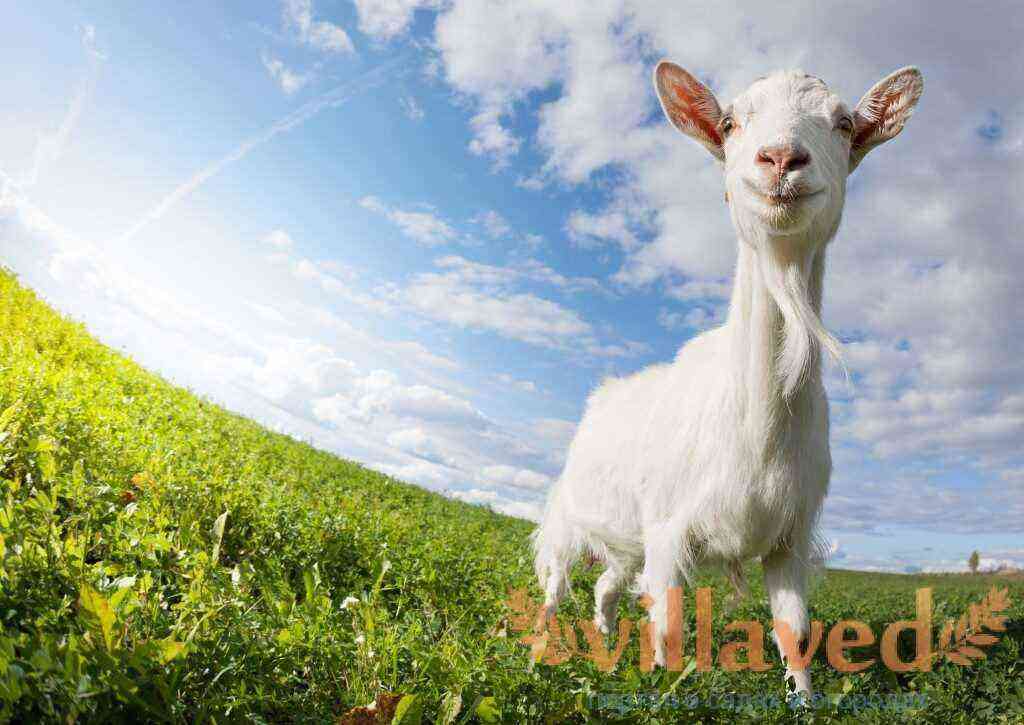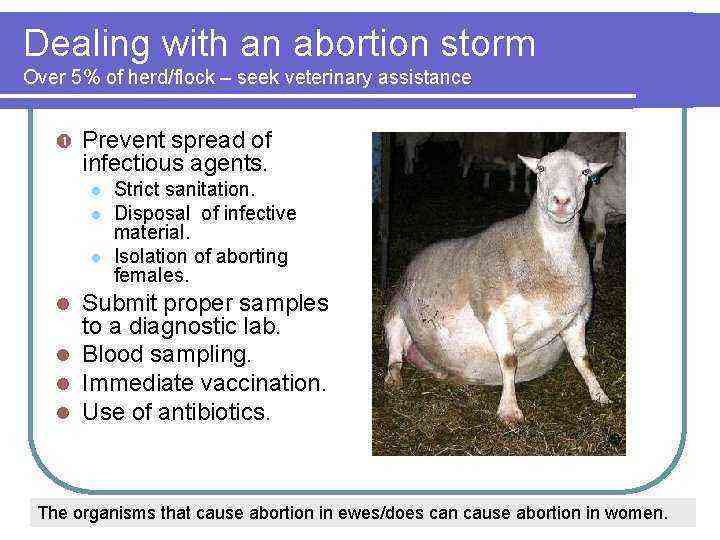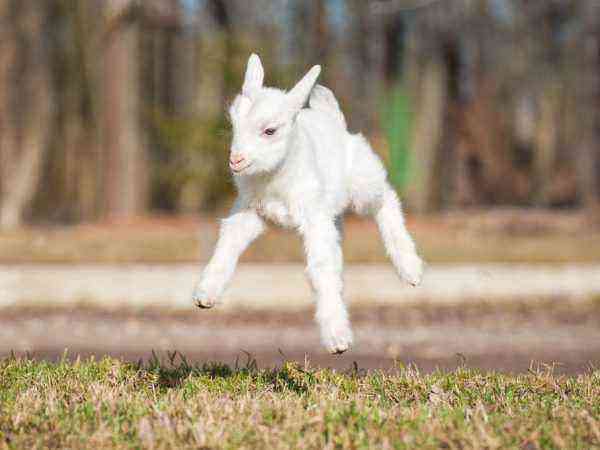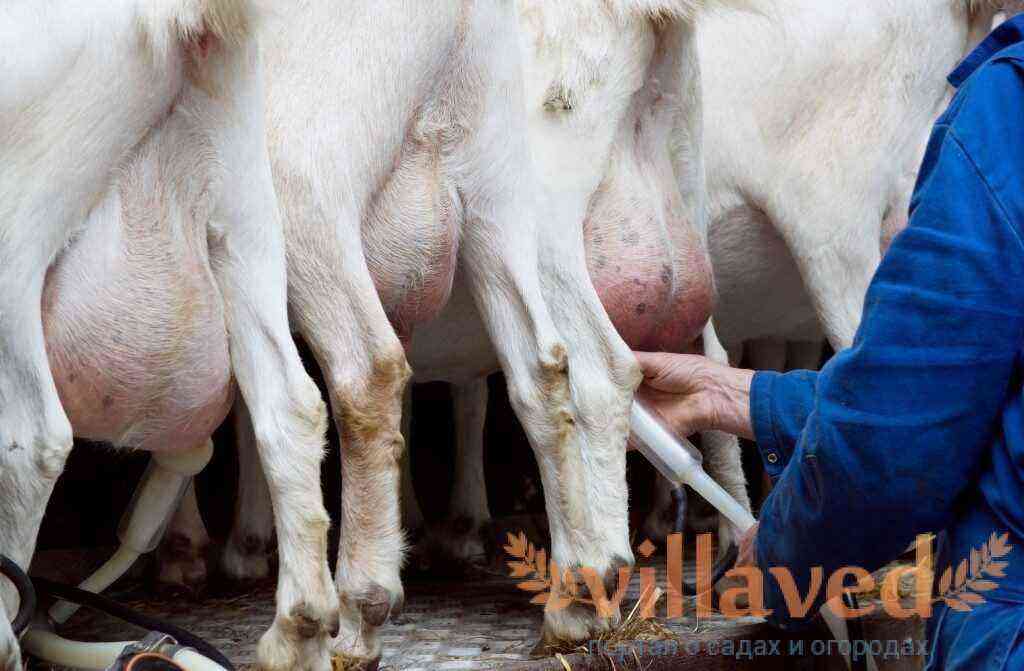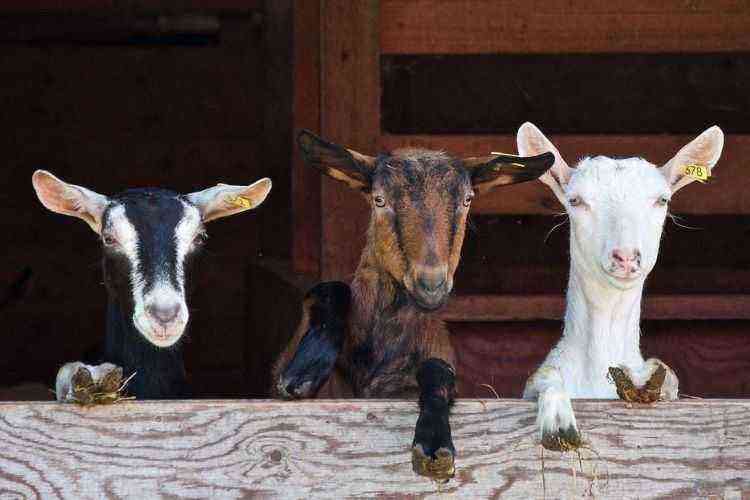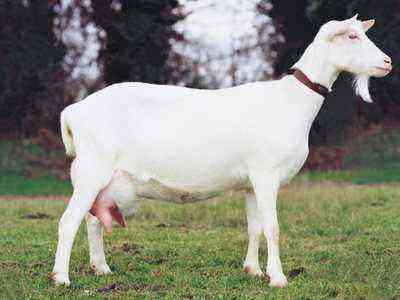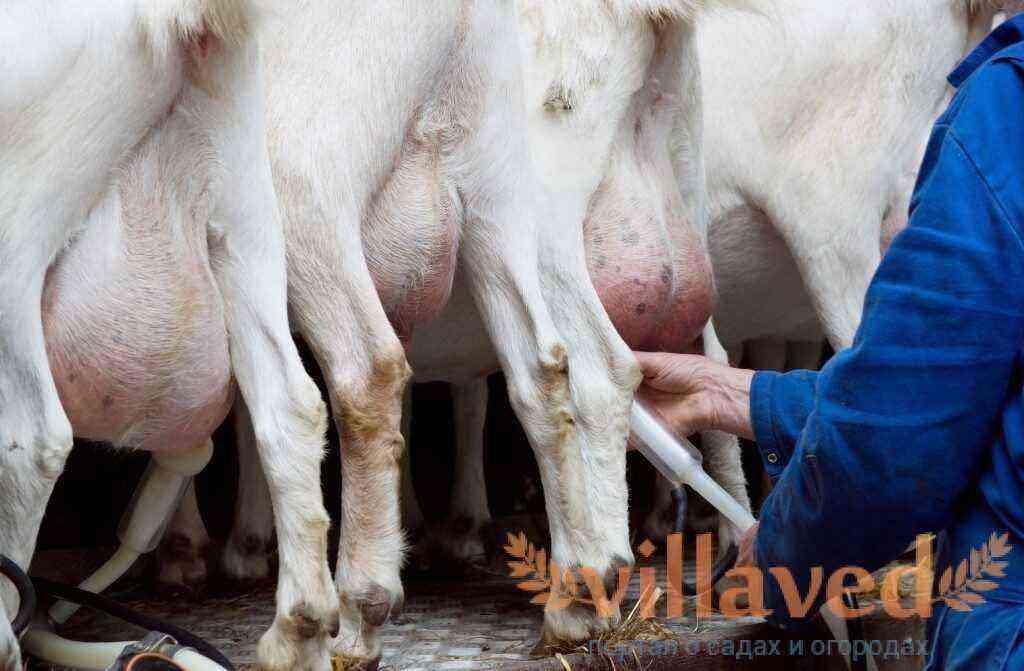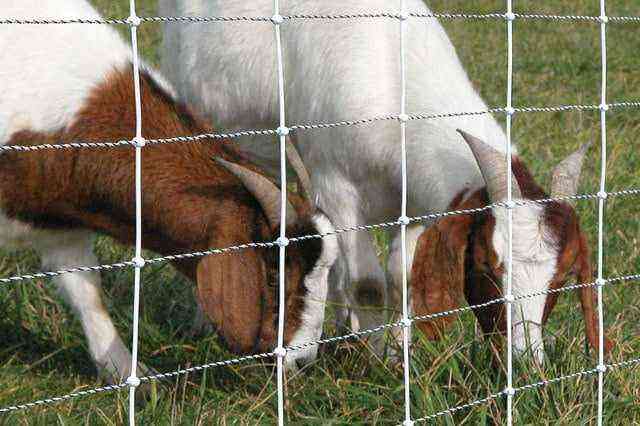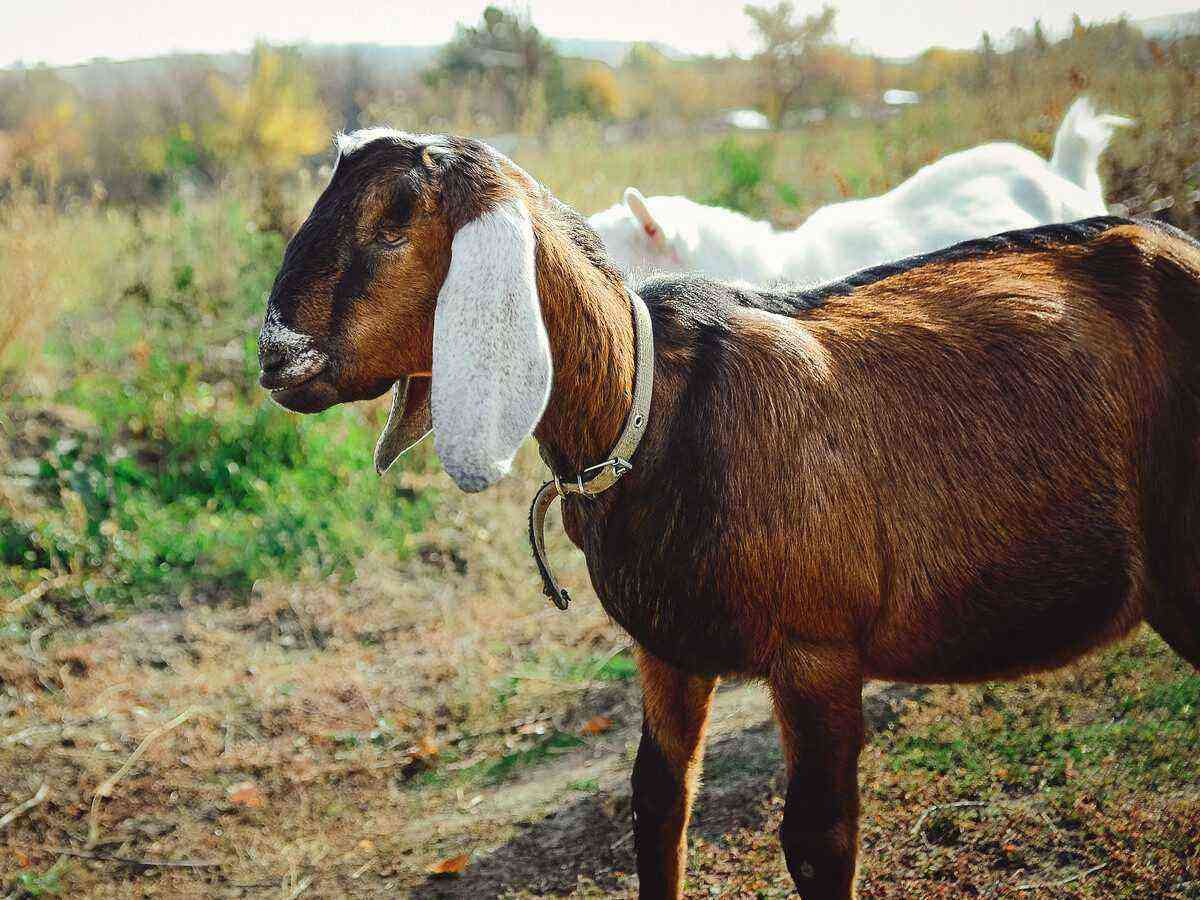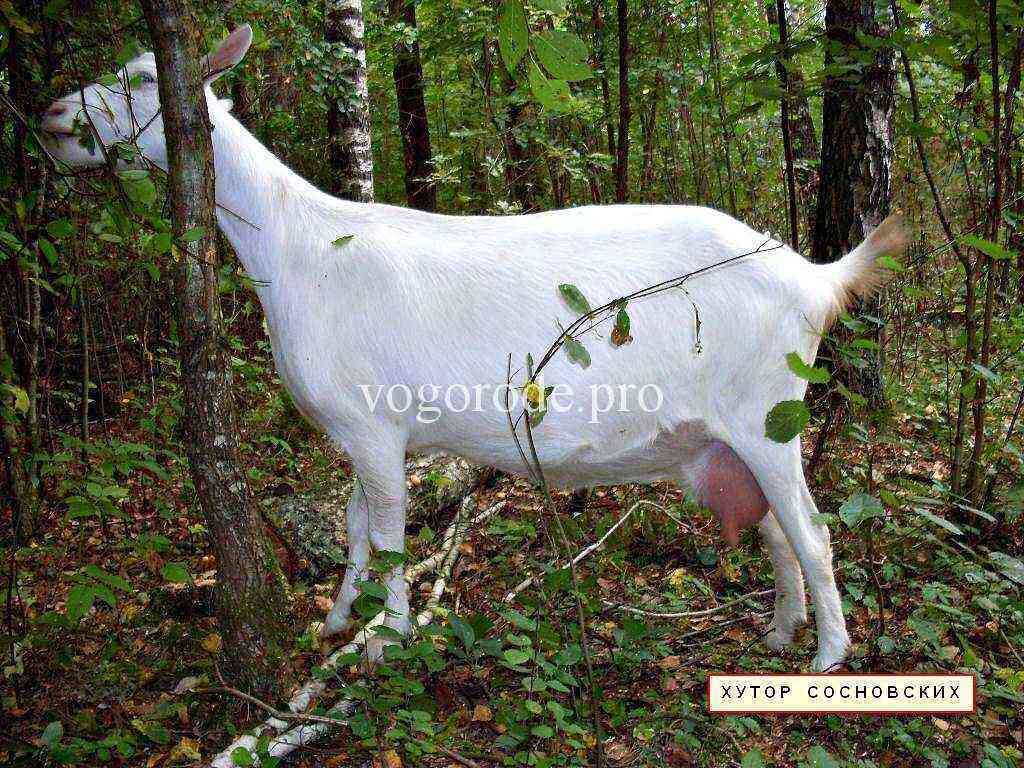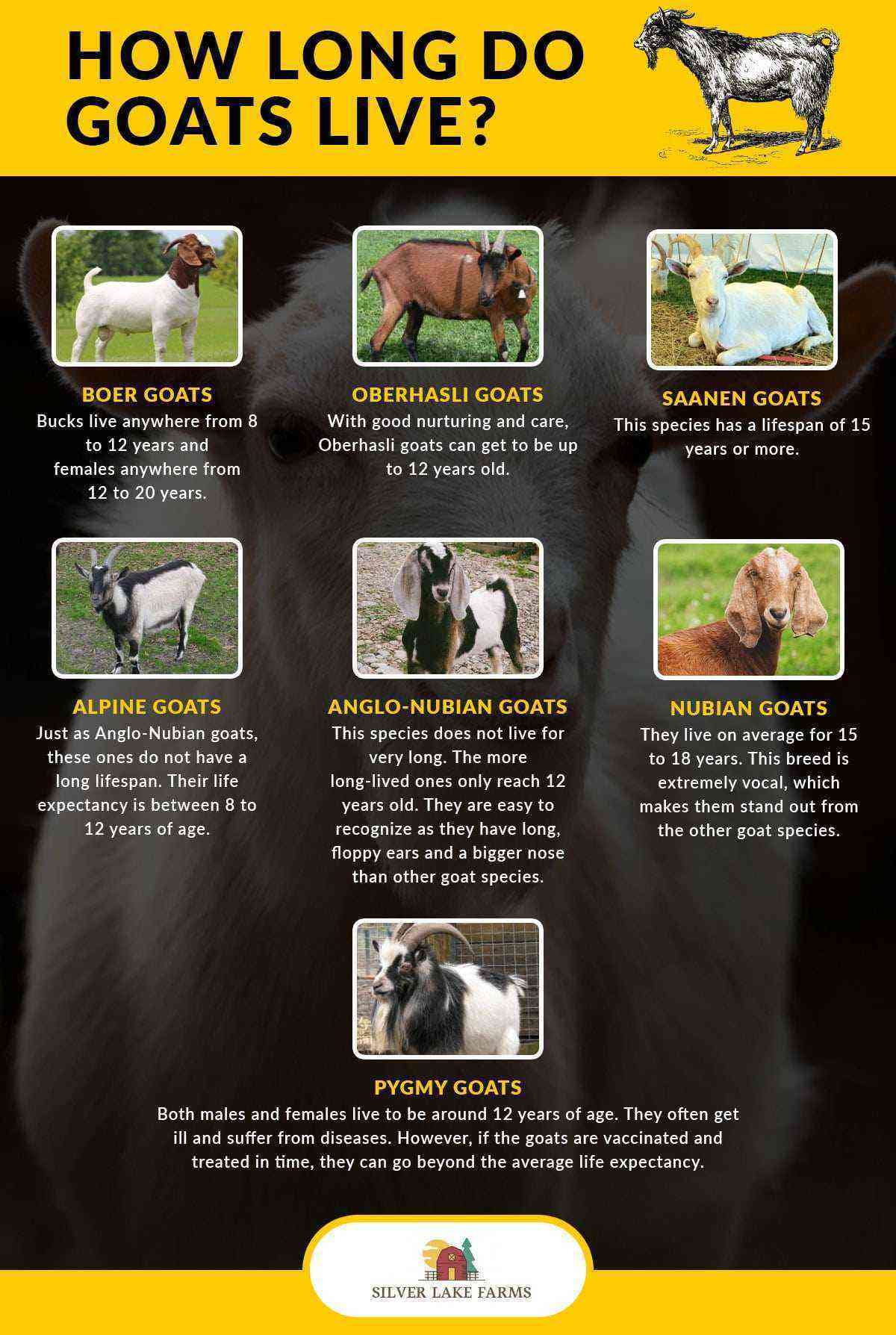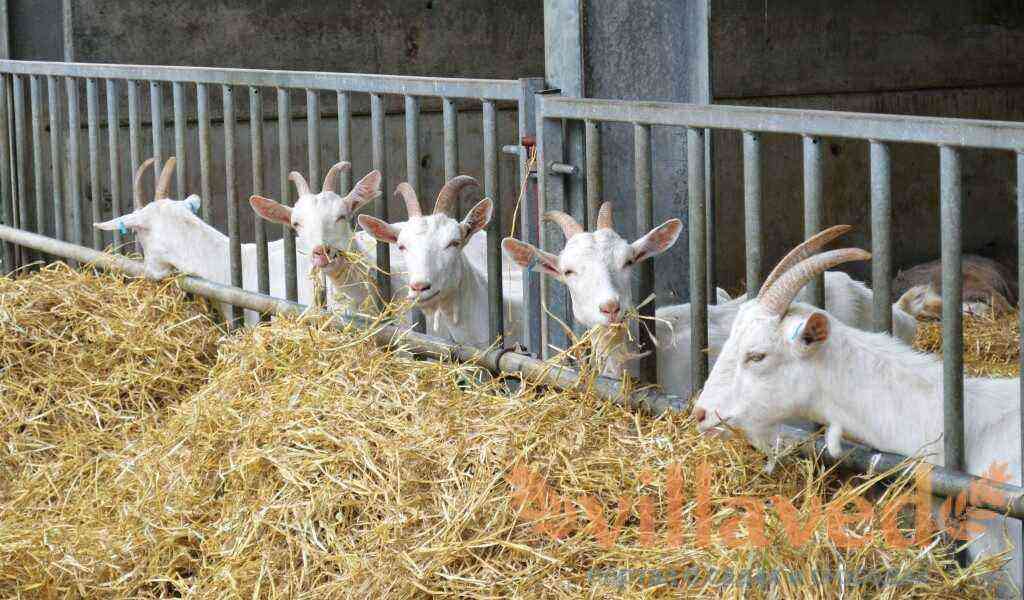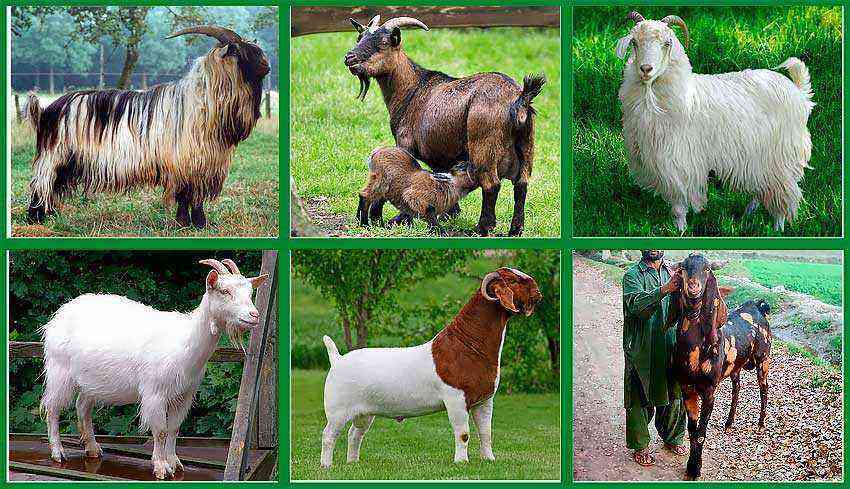Arranging a barn with a special feeder for goats is an important event, since these animals, in the process of eating food, pull it, drop it, and then trample it with their hooves. But at the same time, they will not lift hay or compound feed from the ground – they are too squeamish. Therefore, it is necessary to choose the right design based on different parameters.
appointment
Goats are the most clean and fastidious artiodactyls. In order to maintain their health, it is necessary to use high-quality and always clean feed, which should be varied.
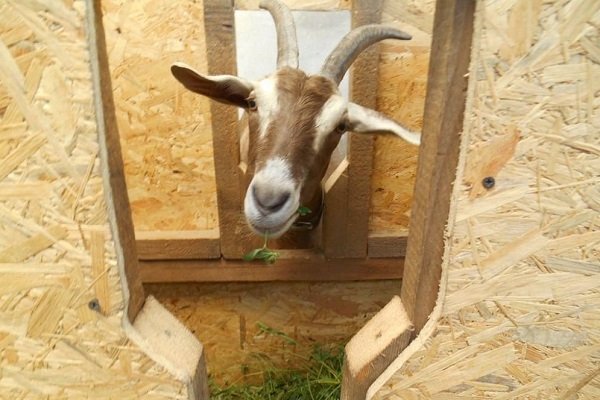
For this reason, feeders of different designs have been developed, ideally suited for all types of products. They are also needed for other purposes:
- reduce the cost of feed (when they fall out, the remains have to be thrown away);
- keeping fresh;
- protection against dirt, dust;
- saving space in the goat house (for this, the nursery is put outside through a hole in the wall).
A properly designed and installed device will provide maximum comfort not only to the goats during the meal, but also to the person who cleans the corral.
feeder requirements
The rules for using goat feeders depend on various factors – what type of food is intended for, how best to preserve the feed, the level of convenience for animals and, most importantly, safety. You can buy a feeder at any specialized store, on the market, but experienced farmers prefer to make them on their own.
Feed safety
The model of the feeder must firmly hold the food from falling out on all sides – this is the main requirement for safety. Otherwise, the farmer will suffer losses, as food mixed with manure is unfit for consumption.
But young kids can also eat from the floor, and this leads to infectious diseases. To save food, consider the following:
- if it is not possible to make a new feeder, substitute a wide trough under it, where the remains will fall;
- make a two-level nursery;
- the body should be solid, but with holes equal to the size of the goat’s head, so that it can easily crawl inside;
- the height of the “dining room” for adults varies from 130 to 150 cm, for kids – 50-70 cm.
Fasten the feeder to the walls of the barn so that the goats cannot knock it over during games, feeding.
Simplicity of construction
The simpler the model, the easier it is to make it at home, which will additionally save money, time and effort. A simple design is easier to maintain – clean it, wash it, repair it. For this, hanging-type nurseries in the form of a box are used.
The volume of the feeder for a small farm is 30 kg.
Security
When arranging a corral, the farmer must be guided by animal safety rules. This is especially true for devices intended for food, since the head can get stuck in the crevice slot, sharp corners scratch, etc.
Therefore, correctly calculate the size of the holes and follow the basic safety requirements:
- for each goat, allocate an individual feeder, if this is not possible, then a maximum of 2 animals should eat from one design;
- do not make the slots too wide – animals can crawl inside by getting stuck with their feet, but narrow ones cannot be, so the distance between the head and the top / bottom of the slot on each side should be 4-6 cm;
- the width of the hole depends on the spreading of the horn;
- if the barn contains adults and small individuals at the same time, make a feeder with a keyhole-shaped hole – at the top level the gap is much wider than at the bottom;
- the optimal arrangement of the nursery is in one row so that each animal can freely approach its food;
- the design should not contain protruding nails, sharp corners, large chips and the like.
Since goats gnaw on wooden products, do not cover them with paints and varnishes. This will lead to intoxication.
Type of feed
For each type of feed, a certain type of feeder is intended. For example, grain will spill out in a manger with large gaps, and hay will get stuck in bunker structures, clogging pipes.
There are several main categories, depending on the food for goats:
- For hay. The structure is large (the size depends on the weight of the bales) and open with gratings and crossbars. They are arranged so that the animal can freely reach the hay, but could not climb inside. The ideal option is French fixtures and a regular nursery.

- For grass. The most commonly used floor structure, the top of which is equipped with crossbars. The main requirement is a reliable fixation to the floor, excluding overturning.

- Grain, feed. Bulk food should be in closed feed bins made of PVC pipes. The principle of operation is to supply grain from the top of the pipe, after which the feed moves down.
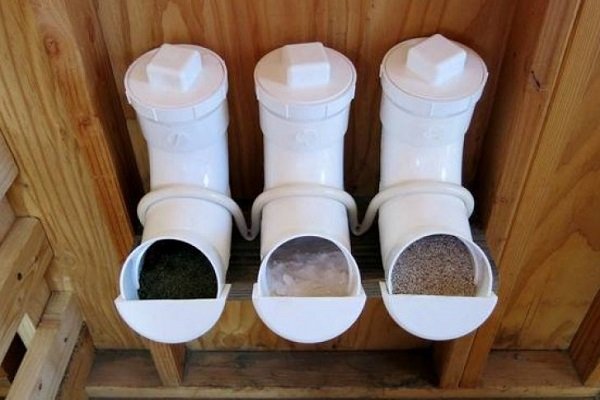
There are combined options that combine 2-3 types of feeders at once. At home, plastic barrels, wood, etc. are used for this.
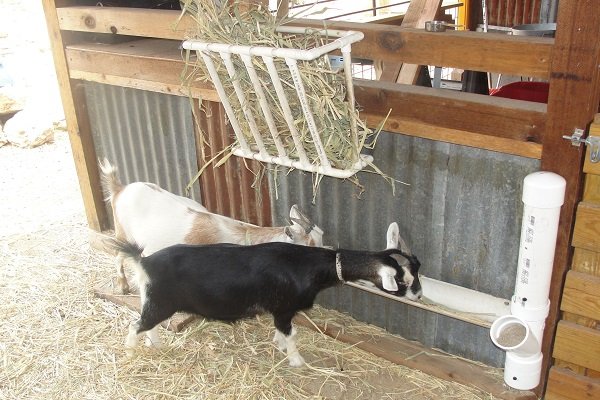
Main types and their schemes
Goat feeders are divided into groups based on mobility indicators:
- stationary – they cannot be moved from their place, since they are fixed to the barn surface (wall / floor);
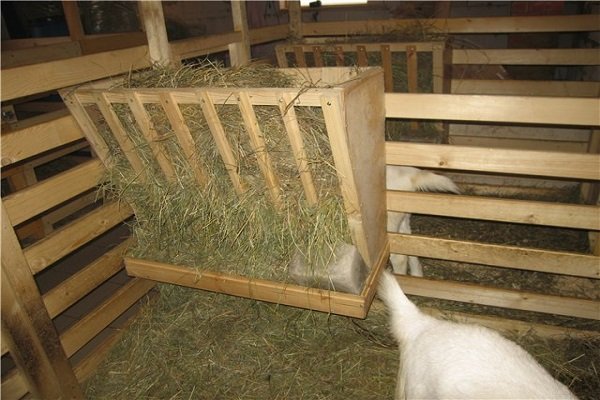
- mobile – easy to move during cleaning / rearrangement;
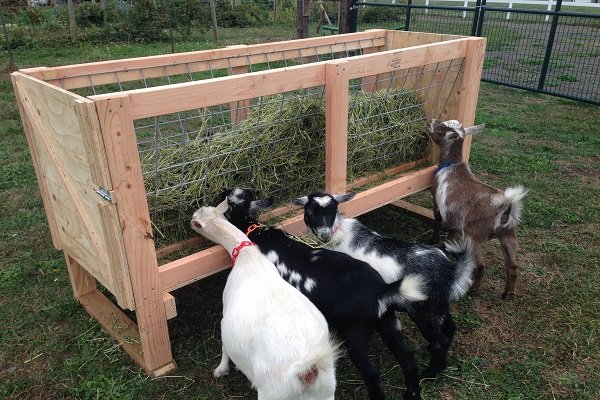
- reclining (folding) – those that, if necessary, can be folded or fastened to the wall.
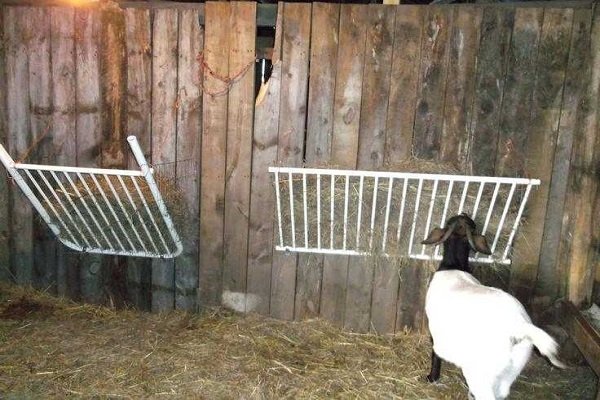
Schemes for the manufacture of feeders vary, but there are a number of nuances that are required for all types of feeders:
- size in length for young animals up to 20 cm, adults up to 40 cm;
- height from floor to tank – about 50 cm;
- the height of the entire structure is 100-150 cm;
- the distance between the crossbars – for kids up to 6 months 8-10 cm, for goats – 20-25 cm.
Materials and Tools
To make a goat feeder yourself, you do not need to have a very rich experience, just carefully study the scheme, the sequence of work and prepare the necessary materials and tools.
What you need:
- Base. It is made from wooden boards, bars, plywood, metal sheets, plastic, barrels, PVC pipes.
- Crossbars. For them, stock up on wood slats, mesh netting, hoses, or other suitable improvised materials.
- Fasteners. Use nails, screws, screws, corners.
- Tools. You may need a hacksaw for wood (or metal), a welding machine, a hammer, pliers, a screwdriver, a drill, a chisel, a plane, a jigsaw.
- Aids. These are pencils, crayons, felt-tip pens or markers, a tape measure.
Tools and materials are selected based on the structure to be manufactured.
Toddler type
This is the simplest design that is used most often in households. For manufacturing, wooden elements or metal fittings are required. There are a huge number of models made of wood – it all depends on the imagination of the master.
Classic Edition
Standard nurseries are made in 4 stages – the creation of the frame, the bottom, the top and assembly. Classic scheme with size designation:
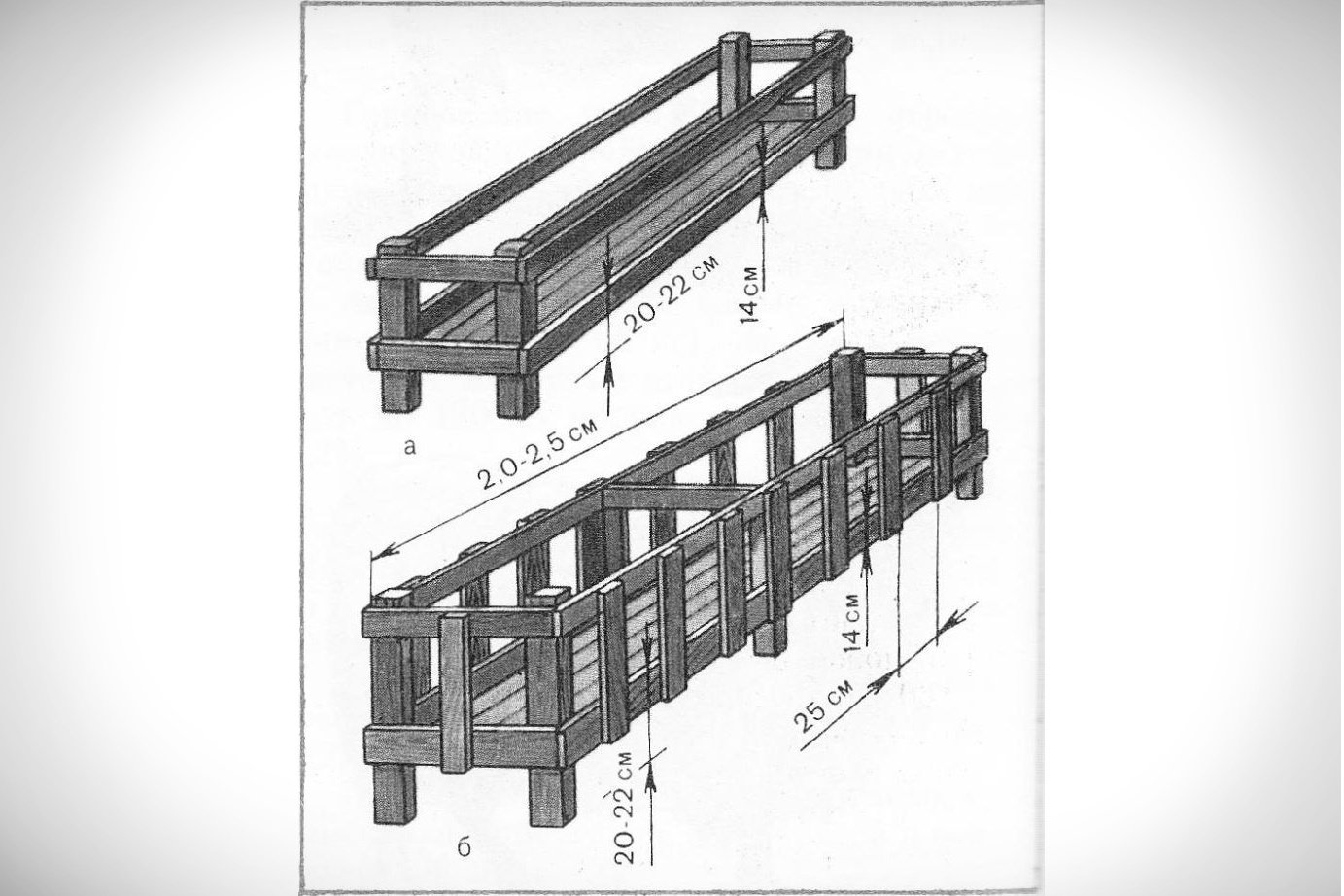
Step-by-step instruction:
- Start with the bottom frame. To do this, take the widest boards – 8 pieces, make markings on them. These will be the sides in length and width.
- Use the bars for the legs – saw off to the desired size (from the floor to the top of the feeder).
- Connect the frame – nail 4 boards around the perimeter.
- Make the bottom – knock several boards into one shield along the width and length of the frame or cut it out of plywood.
- Nail the bottom to the base.
- Connect 4 more boards to the frame at the very top.
- Prepare a few more rails that act as crossbars.
- Nail to the base vertically.
The manger is used for hay and grass.
From reinforcement
Metal structures have a number of advantages – they are heavy, so weighting agents are not needed, they are stable, durable, strong. But for manufacturing, you need skills in working with a welding machine.
What you need:
- galvanized sheets – thickness 2 mm;
- metal rods – diameter 18 mm;
- pipes – diameter 12 mm;
- reinforcement – thickness 8 mm.
The armature can be replaced with soft wire of the same size.
Assembly and welding in order:
- Make a frame.
- Cut out the legs (rods are used).
- Prepare the side walls and base of galvanized sheets.
- Weld the grids.
The assembly option, starting from the bottom and ending with the top, is considered optimal.
Despite the many advantages, the nursery from the reinforcement has many disadvantages:
- protruding metal parts are very difficult to round, so sharp elements remain, which violates safety;
- the complexity of the work.
Drawing of metal structures:

Французская
The folk craftsmen of France have their own developed scheme for the manufacture of feeders, which are successful all over the world. Advantages:
- ergonomics;
- profitability – although the hay falls to the floor, it remains in the feeder, so there is no loss of feed;
- convenience for goats;
- versatility (suitable for hay and loose feed).
There is also a minus – there is no cover, so goats can jump over the top. To avoid this, experts recommend 2 ways to solve the problem – to make a roof or increase the structure in height.
Made from wood. Sequence step by step:
- Knock down a box of the desired size. Any material is suitable for this – boards, chipboard, plywood, etc.
- Cut out the legs from the bars. There should be 2 of them, since they are nailed along the width of the frame. Height – no more than 15 cm (so that goats get food from the bottom).
- In the walls along the length (back and front), cut holes suitable for the size of the goats’ heads.
- Process all elements so that there are no chips, etc.
- Connect all elements.
A schematic picture with exact dimensions, from which it is not recommended to deviate (an exception is the height):
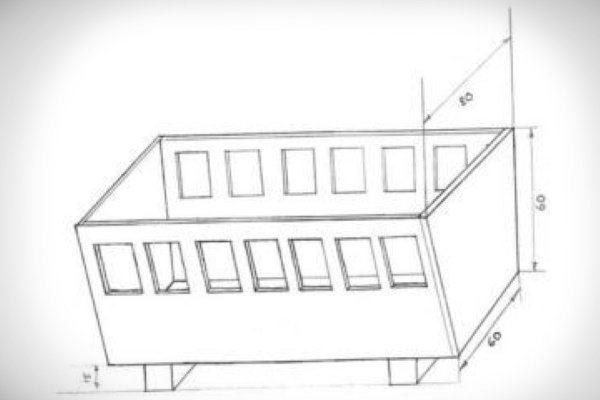
The design optimizes the work of cattlemen, the feeder is rearranged. But the most important thing is that a large amount of feed is immediately laid into it, so you do not need to do this time-consuming work 2-3 times a day.
suspended
The model is considered widespread and simplified. Purpose – straw, hay. Placed on the walls of the barn, gates, partitions and other vertical structures. Differs in profitability and simplicity of production as it is required to make only 1 or 3 walls.
How to make it:
- Prepare the bars, slats, fasteners and tools.
- Attach a beam to the wall, having the following indicators: length 40 cm, cross section 50 mm. If a board is used, then the thickness should be 35-40 mm, width 10 cm. The distance from the floor to the lower tier of the feeder is 20-25 cm.
- Step back from the bottom beam 80 cm. Nail another board horizontally.
- Connect with vertical bars on the sides.
- To the lower, middle and upper parts, nail a bar on each side so that they are parallel to the floor and point forward.
- Connect the top boards with a bar too. On it, nail the slats going vertically down to the bottom element attached to the wall.
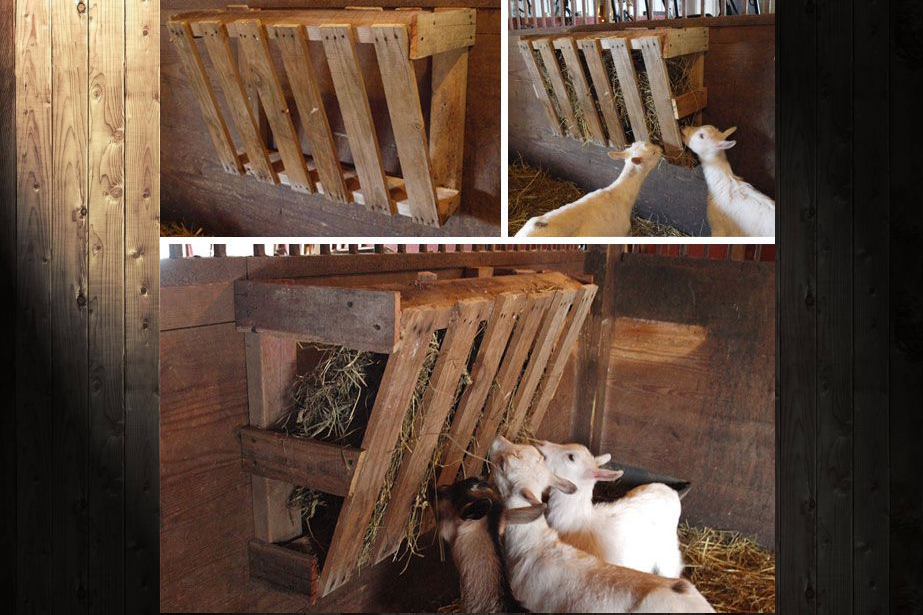
There are other options:
- corner – it is enough to nail the boards on the sides of the corner and connect them to the finished structure (from rails, a playpen, metal rods, an old bed, etc.);
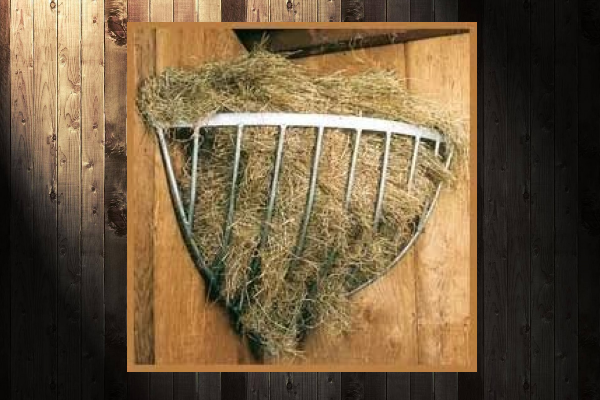
- mesh – chain-link – a piece is simply attached to the wall;
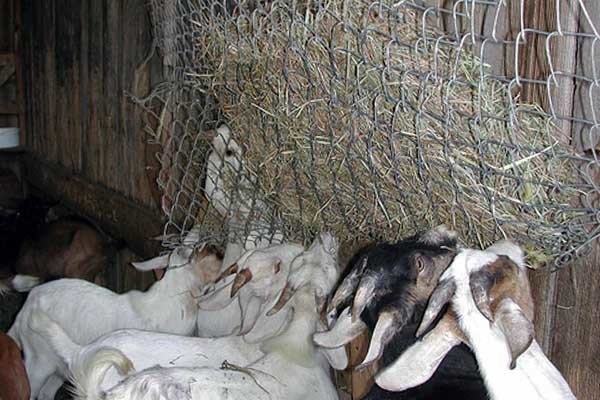
- barrel – make windows in it.

A significant disadvantage is the loss of food, as it wakes up on the floor. Alternatively, you can install a clean trough from below.
From a plastic barrel
Great feeders are made from old plastic barrels, as long as they are non-toxic. Therefore, you can not use products in which fuels and lubricants (fuel and lubricants) and the like were stored. If there is a barrel of glue, paint, etc., thoroughly clean it before use (with special products or laundry soap).
Pay attention to such features – there should not be large cracks, the material must be durable.
Horizontal
A structure installed horizontally always has longitudinal cuts.
Manufacturing rules:
- Lay the container on its side, mark the height of the cut (from 5 to 15 cm from the bend that comes to naught.
- Draw a line with a felt-tip pen, cut along the entire length with a jigsaw. This will be the top where the food is laid. Do not throw away the rest – it can be used as a cover, for example, if you install the structure on the street.
- On two sides, measure 3-4 points for the windows. Draw holes with a marker and cut out.
- On the bottom, make small holes for water to drain (just in case).
- Sand all cuts with sandpaper.
- Make a wooden frame in which the barrel will be installed.
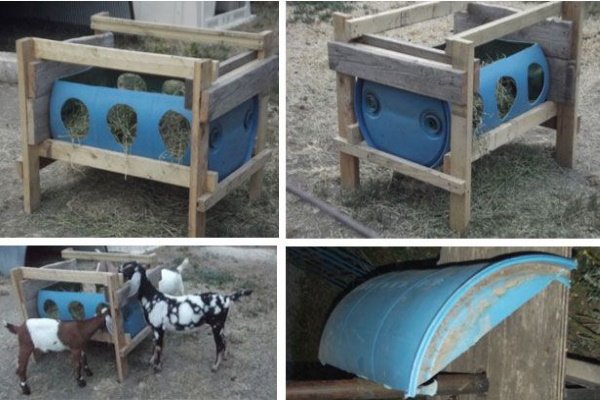
The vertical
This type involves the installation of the structure vertically. The main advantage is saving space and material, because 2 L-shaped feeders can be made from one barrel at once.
Step-by-step instruction:
- Lay the plastic product on its side or leave it standing.
- Draw the letter G with a felt-tip pen on both sides so that this shape is obtained after cutting. The distance from the bottom on one side and the lid on the other is 20-25 cm.
- Cut the structure, then carefully process the sections.
- Attach a chain-link mesh with large cells to the free plane. If there is no netting, use soft wire.
- Install on a substrate.
Farmers claim that barrels, due to their low weight, are unstable, therefore, for fixation, such feeders are attached to vertical structures (fences, etc.).
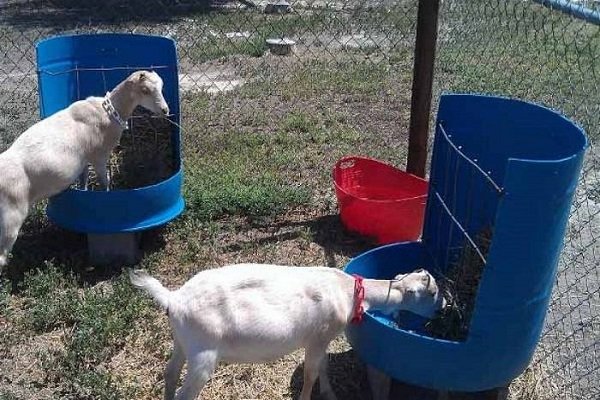
From pipes
For the construction, plastic water pipes with a minimum diameter of 10-15 cm are used. The main condition is not to take old items, they can be toxic to goats. Additionally, you will need plugs (2 pcs.) And a 45º tee. The length is arbitrary, but the longer the pipe, the more stability decreases. The optimal size is 120-150 cm.
Manufacturing process:
- Divide the pipe into 3 parts as shown in the figure below. Treat cuts immediately.
- Insert a 70 cm segment into the tee – this will be the top.
- Place a 20 cm part in the tee from below.
- Mount the smallest piece (10 cm) into the side outlet of the tee, from where the goats will eat.
- Cover the bottom of the entire structure with a plug.
- Put a cap on top that will be easy to open.
- Attach to the structure with clamps.

Sennik from boards
This is a budget option with the construction of which a beginner can handle. The length of the board should match the number of goats.
How to make:
- Nail 2 boards into the corner of the barn – one on top, one on the bottom.
- Attach 1 more rail (distance from 80 to 90 cm). This will be the frame.
- Take small picket fences, make lattices out of them.
For paddocks and stalls
Most often in a small goat house there are feeders for 1 or a maximum of 5 goats, but for farms it is more convenient to use ordinary nurseries. They are arranged in one long row, most often under the wall to save space. But the design can be two-sided.
The best option for large livestock is folding structures, which simplifies the process of cleaning the barn. To build a simple stall feeder, metal pipes or wood are used. Designs can be very diverse.
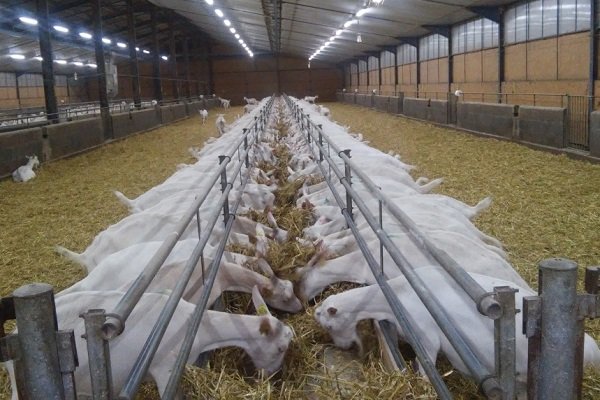


For the summer paddock, farmers build portable structures. They are then installed in the winter goat house.
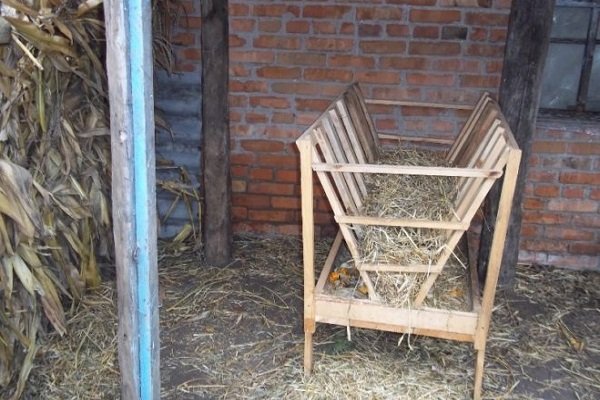
The main thing in the manufacture of all models is the creation of a base frame and crossbars / mesh.
For a goat with kids
In order to feed both goats and kids with hay at the same time, experts came up with a universal nursery with crossbars made of solid boards, in which uneven holes are cut out – the lower slot is for babies, the upper slot is for mothers.

But there are other options that are desirable to put in a goat’s house with kids.
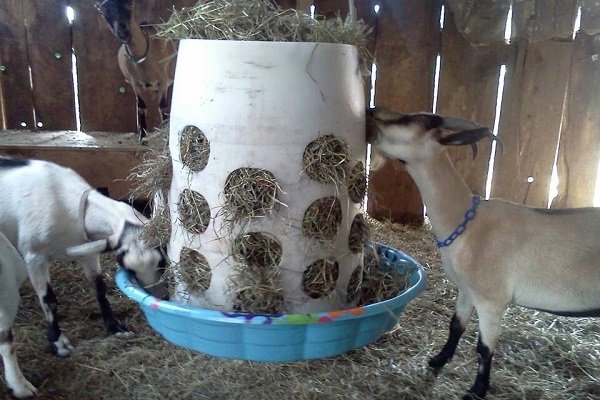

Box for drying and granules
After giving birth, the female requires enhanced nutrition, as do the kids themselves, so it is necessary to feed them with granulated and chopped feed. Such a box can be built independently. What is needed for this is plywood, transparent plastic / plexiglass, fastening materials.
Diagram:
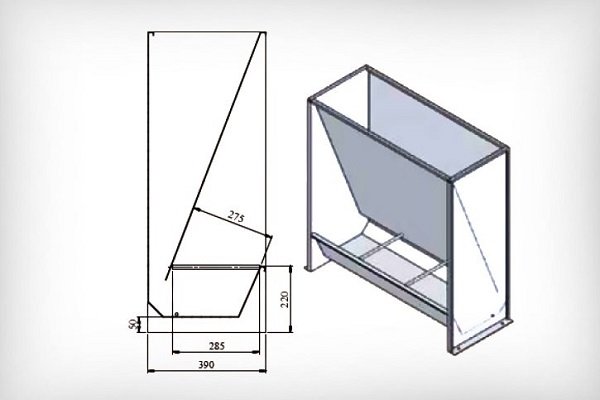
The construction process includes the following steps:
- Cut out 2 side walls, front, bottom and cover from plywood sheet.
- Make the back wall of Plexiglas.
- Connect all the parts of the box into one frame so that the front element is at an angle of 45 °.

metal dispenser
There is the best option for distributing metal feeders – steel cone-shaped. It can be portable or mounted.
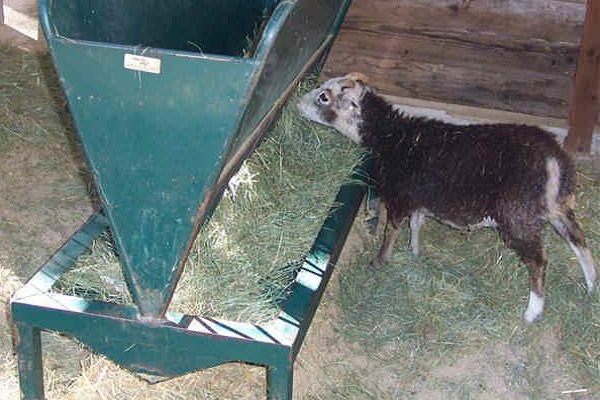
Stages of manufacture:
- Weld 4 steel sheets with a welding machine – 2 in width, 2 in length, but so that a cone is obtained. Leave a slot at the bottom for feeding hay or other feed. Please note that the products should not get stuck in the cut and spill too much. Therefore, the angle of connection on 2 sides is from 15 to 18 °.
- Make a pallet with legs.
- Attach a dispenser to it.
Goat breeders advise to make a lattice wall on one side of the distributor, thanks to which the mother goat will also be able to feast on hay.
Goat drinkers
Drinking containers are of 2 types – wall and floor. The first option is considered the most acceptable, since in it the water remains clean for a long time and does not overflow.
Drinkers can be simple or with automatic liquid supply (inside with a dispenser). At home, various improvised materials are used to make drinking bowls:
- bucket;
- plastic bottles;
- basins;
- water pipes, etc.
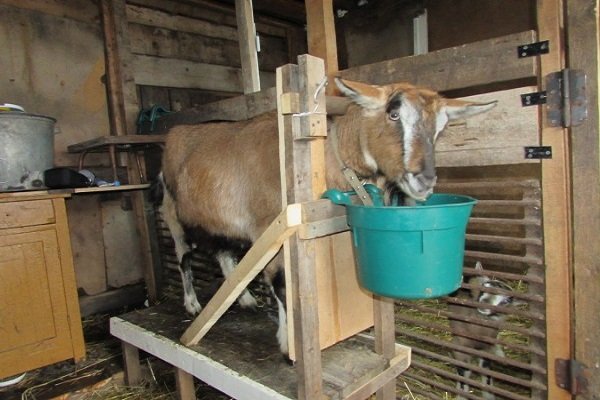
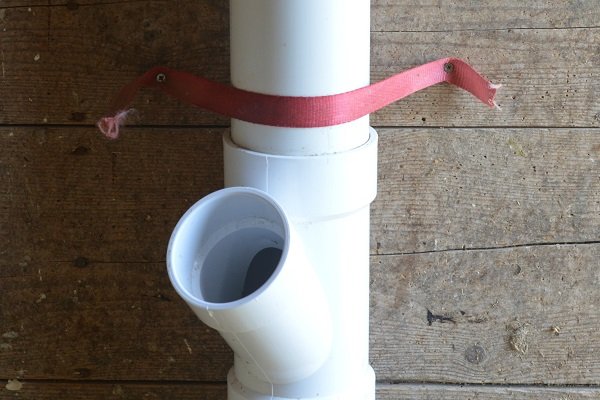
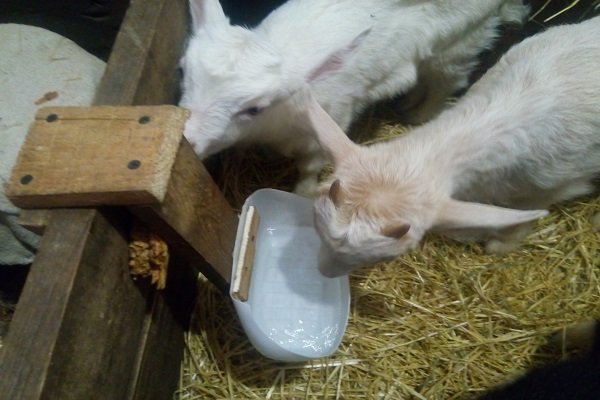
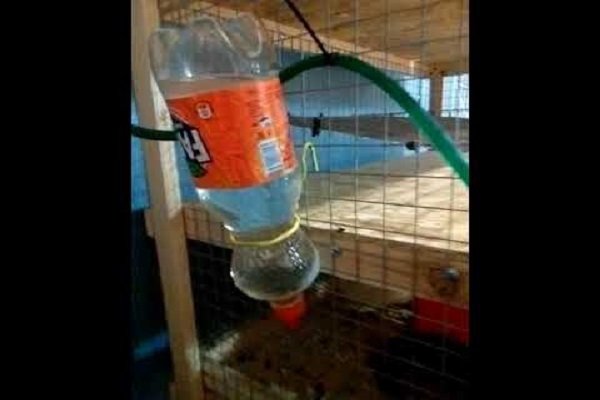
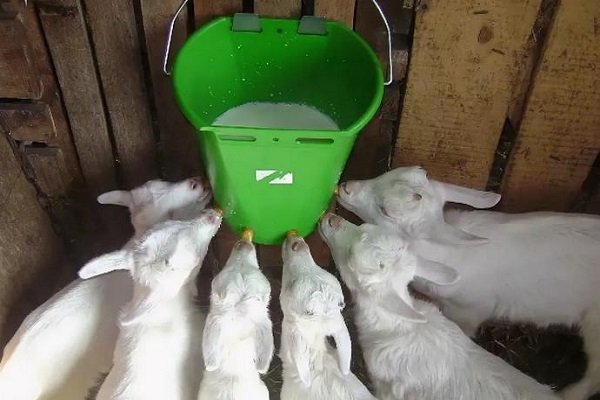
How to remake bad models?
If a mistake is made in the production of a goat feeder, do not rush to despair, because the defect can be corrected:
- with a very low location of the manger, just nail the legs;
- if the distance between the slats is excessive, add pickets (sometimes you need to pull out the previous ones first);
- if the horns get stuck in the cell feeder when turning the head, reduce the depth and increase the width of the opening.
In order to avoid mistakes, carefully study the diagrams and drawings, accurately carry out all calculations.
Building goat feeders at home is not a problem for professionals and beginners. The main thing is to find building materials, stock up on fasteners and tools. If you are not confident in your own abilities, call on the help of friends who are at least a little versed in carpentry.

